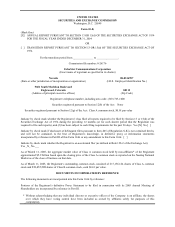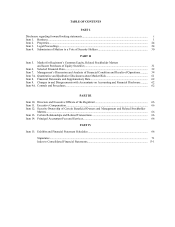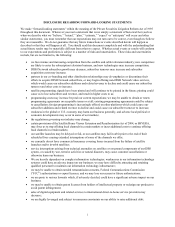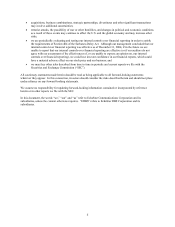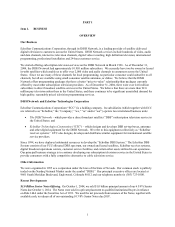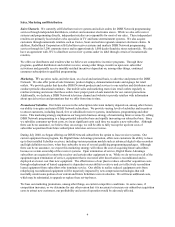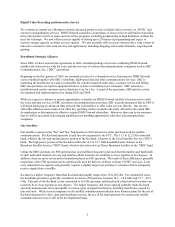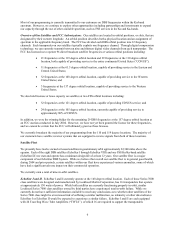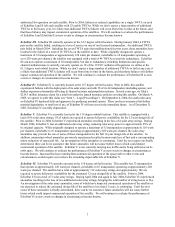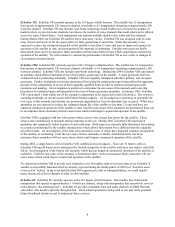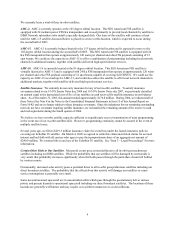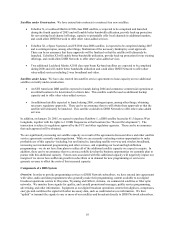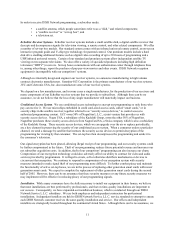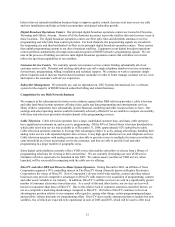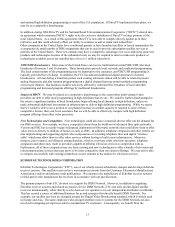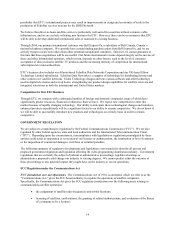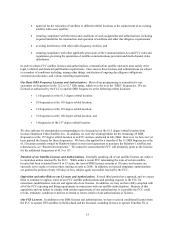Dish Network 2004 Annual Report Download - page 13
Download and view the complete annual report
Please find page 13 of the 2004 Dish Network annual report below. You can navigate through the pages in the report by either clicking on the pages listed below, or by using the keyword search tool below to find specific information within the annual report.5
Digital Video Recording and Interactive Service
We continue to expand our offerings to include advanced products such as digital video recorders, or “DVRs” and
interactive programming services. DISH Network customers can purchase or lease receivers with built-in hard disk
drives that permit viewers to pause and record live programs, including programming in high definition, without the
need for videotape. We now offer receivers capable of storing up to 210 hours of programming and expect to
increase storage capacity on future receiver models. We also currently offer receivers that provide a wide variety of
innovative interactive television services and applications, including shopping and weather channels, wagering and
gaming.
Broadband Strategic Alliances
Since 2002, we have entered into agreements to offer a bundled package of services combining DISH Network
satellite television service with the voice and data services of various telecommunications companies such as SBC
Communications, Inc. (“SBC”) and others.
Beginning in the first quarter of 2004, we commenced sales of a co-branded service featuring our DISH Network
service bundled together with SBC’s telephony, high-speed data and other communications services. SBC is
marketing the bundled service and is responsible for certain integrated order-entry, customer service and billing.
SBC also purchases set-top box equipment from us to lease to bundled service customers. SBC outsources
installation and certain customer service functions to us for a fee. As part of the agreement, SBC paid us certain
development and implementation fees during 2003 and 2004.
While we expect to continue to pursue opportunities to bundle our DISH Network satellite television service with
the voice and data services of SBC and other telecommunications providers, SBC recently announced that in 2005 it
will begin deploying an advanced fiber network that will enable it to offer video services directly. Our net new
subscriber additions and certain of our other key operating metrics would be adversely affected to the extent SBC
de-emphasizes or discontinues its efforts to acquire DISH Network subscribers. Moreover, there can be no assurance
that we will be successful in developing significant new bundling opportunities with other telecommunications
companies.
Our Satellites
Our satellites operate in the “Ku” and “Ka” band portions of the microwave radio spectrum used for satellite
communications. The Ku-band spectrum is split into two segments by the FCC. The 11.7 to 12.2 GHz downlink
band, which is the low and medium power portion of the Ku-band, is known as the Fixed Satellite Service (“FSS”)
band. The high power portion of the Ku-band within the 12.2 to 12.7 GHz downlink band is known as the
Broadcast Satellite Service (“BSS”) band, which is also referred to as Direct Broadcast Satellite or the “DBS” band.
Unlike the DBS spectrum, the FSS spectrum has no predefined frequency plan such that the number and bandwidth
of each individual channel can vary and satellite orbital locations are routinely as close together as two degrees. In
addition, there are more severe power limitations placed on FSS spectrum. The result of these differences generally
means that, while FSS spectrum can be satisfactorily used for delivery of direct to home (“DTH”) services, it can
carry somewhat less capacity and generally requires a slightly larger user antenna or consumer dish to adequately
receive signals from a satellite.
Ka-band is a higher frequency band than Ku-band and roughly ranges from 18 to 40 GHz. For commercial users,
the downlink spectrum is generally considered to consist of frequencies between 18.3 – 18.8 GHz and 19.7 – 20.2
GHz. This part of the Ka-band is also considered to be FSS spectrum, and therefore Ka-band orbital locations can
routinely be as close together as two degrees. The higher frequency and closer spacing generally make Ka-band
spectrum transmissions more susceptible to various types of signal interference, including interference caused by
rain and snow. While several companies in the satellite communications industry have business plans for the use of
Ka-band spectrum for video, data and broadband services, the use of Ka-band spectrum for commercial satellite
communication services is still in the developmental stage.




